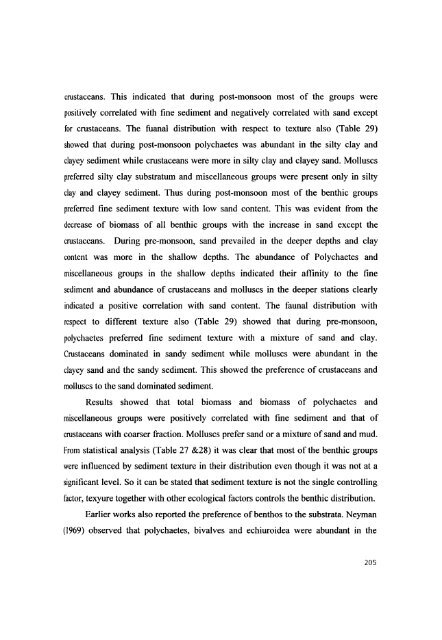L - Cochin University of Science and Technology
L - Cochin University of Science and Technology
L - Cochin University of Science and Technology
Create successful ePaper yourself
Turn your PDF publications into a flip-book with our unique Google optimized e-Paper software.
crustaceans. This indicated that during post-m on soon most <strong>of</strong> the groups were<br />
positively correlated with fine sediment <strong>and</strong> negatively correlated with s<strong>and</strong> except<br />
for crustaceans. The fuanal distribution with respect to texture also (Table 29)<br />
showed that during post-monsoon polychaetes was abundant in the silty clay <strong>and</strong><br />
clayey sediment while crustaceans were more in silty clay <strong>and</strong> clayey s<strong>and</strong>. Molluscs<br />
preferred silty clay substratum <strong>and</strong> miscellaneous groups were present only in silty<br />
clay <strong>and</strong> clayey sediment. Thus during post-monsoon most <strong>of</strong> the benthic groups<br />
preferred fine sediment texture with low s<strong>and</strong> content. This was evident from the<br />
decrease <strong>of</strong> biomass <strong>of</strong> all benthic groups with the increase in s<strong>and</strong> except the<br />
crustaceans. During pre-monsoon, s<strong>and</strong> prevailed in the deeper depths <strong>and</strong> clay<br />
content was more in the shallow depths. The abundance <strong>of</strong> Polychaetes <strong>and</strong><br />
miscellaneous groups in the shallow depths indicated their affinity to the fine<br />
sediment <strong>and</strong> abundance <strong>of</strong> crustaceans <strong>and</strong> molluscs in the deeper stations clearly<br />
indicated a positive correlation with s<strong>and</strong> content. The faunal distribution with<br />
respect to different texture also (Table 29) showed that during pre-monsoon,<br />
polychaetes preferred fine sediment texture with a mixture <strong>of</strong> s<strong>and</strong> <strong>and</strong> clay.<br />
Crustaceans dominated in s<strong>and</strong>y sediment while molluscs were abundant in the<br />
clayey s<strong>and</strong> <strong>and</strong> the s<strong>and</strong>y sediment. This showed the preference <strong>of</strong> crustaceans <strong>and</strong><br />
molluscs to the s<strong>and</strong> dominated sediment.<br />
Results showed that total biomass <strong>and</strong> biomass <strong>of</strong> polychaetes <strong>and</strong><br />
miscellaneous groups were positively correlated with fine sediment <strong>and</strong> that <strong>of</strong><br />
crustaceans with coarser fraction. Molluscs prefer s<strong>and</strong> or a mixture <strong>of</strong> s<strong>and</strong> <strong>and</strong> mud.<br />
From statistical analysis (Table 27 &28) it was clear that most <strong>of</strong> the benthic groups<br />
were influenced by sediment texture in their distribution even though it was not at a<br />
significant level. So it can be stated that sediment texture is not the single controlling<br />
factor, texyure together with other ecological factors controls the benthic distribution.<br />
Earlier works also reported the preference <strong>of</strong> benthos to the substrata. Neyman<br />
(1969) observed that polychaetes, bivalves <strong>and</strong> echiuroidea were abundant in the<br />
205

















